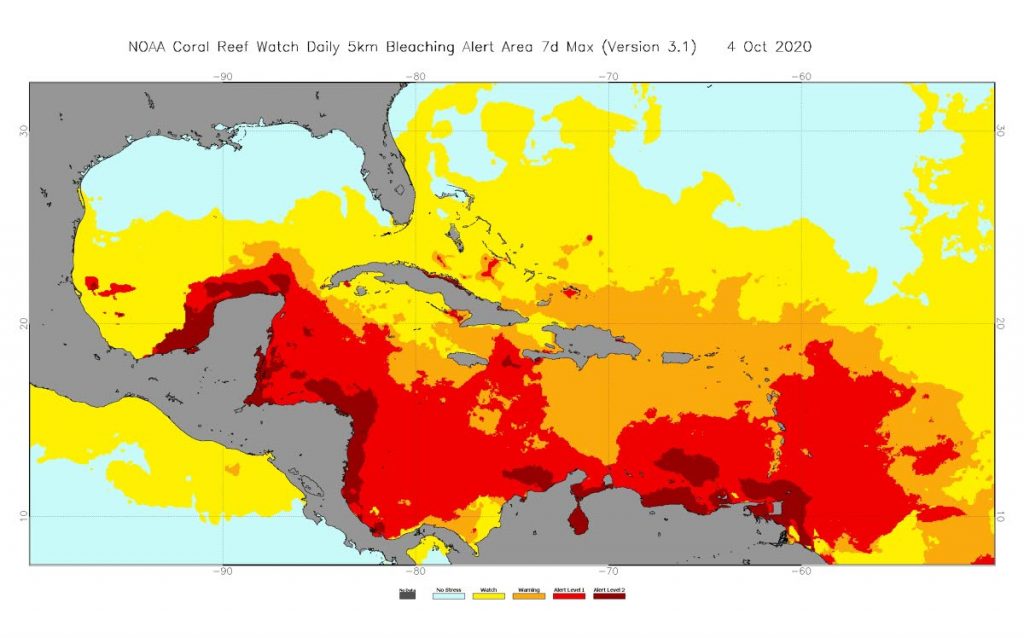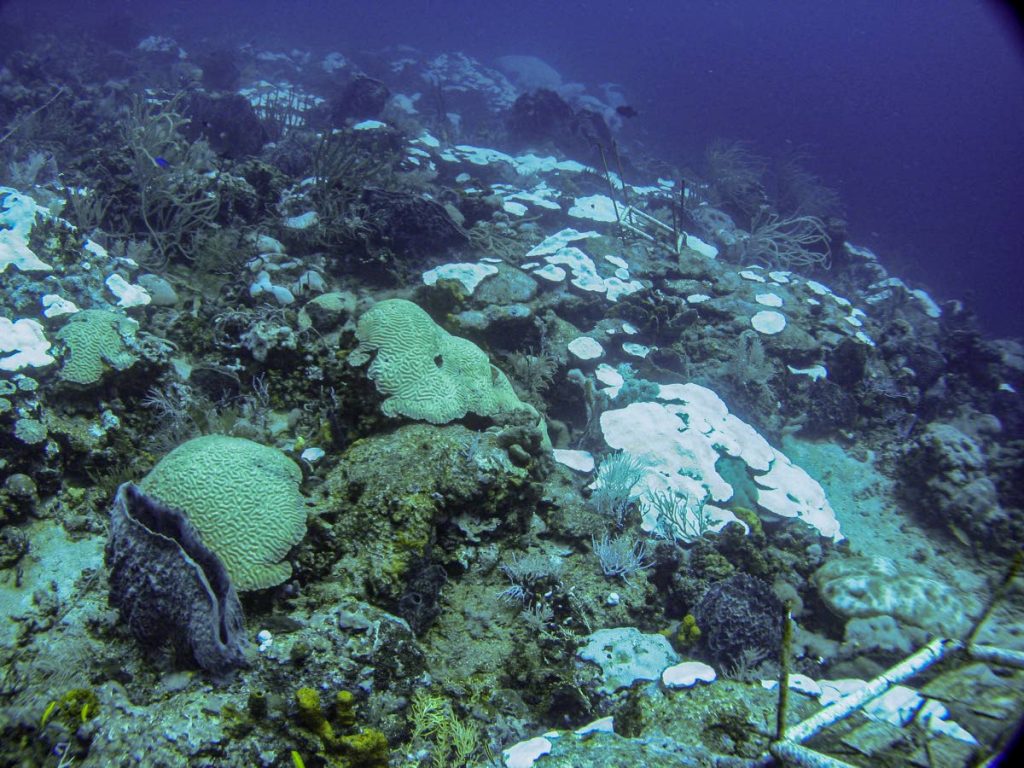Caribbean Sea heating up

The hot Caribbean Sea has implications for more than storms and hurricanes. Coral reef ecologist Dr Anjani Ganase warns of other dangers in the warming ocean. The outlook for coral reefs around Tobago – and impacts on livelihoods – ten years after the last significant event looks grim.
These days we can feel the heat on the land and in the sea. With the increasing effects of a warming world and the changing climate, the months of September and October are especially challenging for coral reef scientists. Forty years ago, the water temperature would – on occasion – get too warm for corals. These days, ocean temperatures are rising annually to temperatures that may be too warm even for tropical coral reefs.
Coral Reef Watch
Coral Reef Watch was developed by NOAA (National Oceanographic and Atmospheric Administration, USA) following the first major global coral bleaching event in 1997/1998. They realised that coral reefs around the world were bleaching during the summer months as tropical water temperatures were simply getting too hot for the corals. This led to the corals bleaching and dying globally. Launched in 2000, Coral Reef Watch delivers alerts about coral bleaching threats using satellite information on sea surface temperatures and predicts the likelihood of bleaching based on the rate of thermal heating of the water.
Satellite observations were calibrated with direct observations of water temperatures and coral bleaching along tropical coastal waters. The metric to determine the risk of bleaching is measured in Degree Heating Weeks. This is the cumulative heat stress that corals experience over a 12-week window. The accumulation of heat stress is calculated by the amount degrees above the thermal summer mean temperature and the number of days that it persists above the mean value. From this, NOAA can provide weekly bleaching alerts for areas where bleaching may be possible at specific locations. Here are the alert levels:
Bleaching Watch – low-level heat stress present
Bleaching Warning – heat stress is accumulating, possible coral bleaching
Bleaching Alert Level One – significant bleaching across species and over-extended areas is likely
Bleaching Alert Level Two – severe bleaching and coral death are likely
What is coral bleaching?
Corals form a symbiotic relationship with microscopic algae that lives in its tissues. The algae photosynthesises using sunlight and then feeds the coral. The algae gives the corals their amazing bright colours. In return, the coral provides the algae with all essential nutrients and removes the waste. The amount of food provided allows corals to grow to enormous rocky skeletons which are used by other marine organisms for shelter. However, if waters get too warm the relationships between the coral and the algae break down and the algae gets expelled from the coral. This results in coral bleaching where the coral turns white because they lose all their colour.

Current status in the Caribbean
TT and many countries/ islands in the Caribbean are currently at Coral Bleaching Alert Level 2 for the past week and are expected to continue at this status over the next nine-12 weeks.
Bleaching Alert Level 2 has also been observed along certain sections of the Venezuelan and Colombian coasts, while a large body of warm water sits along the central American coastline from Panama, Costa Rica, all the way up to the Mesoamerican Barrier Reef along Belize and Mexico (Yucatan Peninsula).
Meanwhile, the rest of the Windward, Leeward Islands and our neighbours to the west – The ABC islands – are currently at Coral Bleaching Alert Level 1 but all areas are expected to increase to Alert Level 2 by the following week.
Along the Greater Antilles, the Cayman Islands, Jamaica, parts of Cuba and the Southern part of Hispaniola are currently at Bleaching Alert Level 1. The water off the coast of southern Hispañiola is expected to the get to Alert Level 2 within the next two to three months. This may be related to the number of tropical storms occurring in the area.
Places that are now heating up to Bleaching Warning include Northern Hispañiola, Puerto Rico, The Virgin Island, Turks and Caicos and the Bahamas. The Virgin Islands, Puerto Rico, parts of Turks and Caicos and northeast Cuba may get to Bleaching Alert Level 1, while parts of Northern Hispañiola may get to Alert Level 2.
How does predicting help?
The coral bleaching warnings produced by NOAA can assist countries and park managers to prepare resources for coral bleaching mitigation plans alongside existing long-term management plans. The waters cannot be prevented from heating up by any one country or group. We must all advocate for the long-term measures to reduce carbon emissions. Individual countries can work to ensure that the environmental conditions of the coral reefs are suitable for recovery: this includes passive methods, such as closing areas from fishing and local pollution impacts, or active restoration of corals. They can also use the predictions to communicate to communities that depend on the reefs for their livelihoods, so that there is an understanding that the reefs require more care and attention.

Who are our eyes on the reef?
Unfortunately, during the lockdown, our eyes on the reef – tour operators, recreational and professional divers, snorkellers and beach goers – are not able to observe the coral reefs around Tobago. Considering the persistent threat of excessively warm shallow waters over the next couple months, we need to observe the reefs to see how they are doing. Corals in shallow waters and lagoon areas in less than 30 feet are at greater risk, as deeper corals may still be washed by cooling waters.
The last severe bleaching event in Tobago took place in 2010 with many coral species dying and little recovery in the following ten years. It is not understood why recovery of corals is so poor on Tobago’s coral reefs, but until we understand why, it is important to prevent further coral loss for the sake of the health of our reefs and the livelihoods that depend on them.


Comments
"Caribbean Sea heating up"